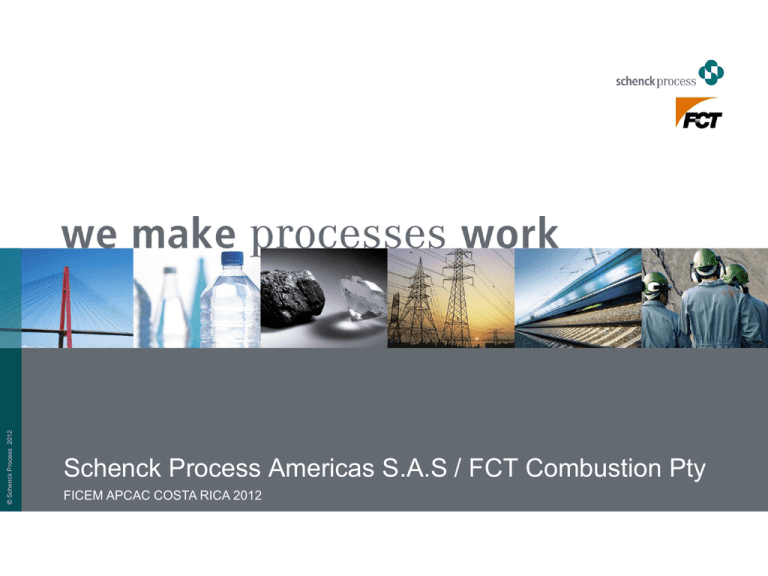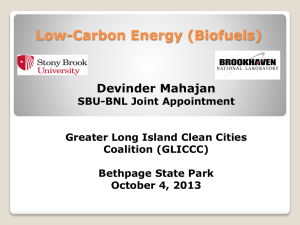7-Sanjiv-Dhanjal
advertisement

© Schenck Process 2012 Schenck Process Americas S.A.S / FCT Combustion Pty FICEM APCAC COSTA RICA 2012 CONTENTS 1 © Schenck Process 2012 2 2 Schenck Process Americas S.A.S Presentation FCT Combustion Pty Ltd Presentation Efficient and Optimum Cement Production with Alternative Fuels By © Schenck Process 2012 Sanjiv Dhanjal (FCT Combustion, USA) and Fernando Garcia (Schenck Process Americas S.A.S, Colombia) 3 Your partner in cement Industry Clay Sand Products: Crusher relief screen Belt weigher Limestone crusher Return grits Flowmeter Bin weighing Mass flow feeders MULTICOR Homogenization Limestone Separator Alternative: SCHENCK Fuel Master Feeding of Alternative Fuels Flow gates Bucket elevator Belt weigher to be installed in apron conveyor Kiln Clinker Gypsum Additive Return grits Separator Store Cementmill Cooler Blaine value Measurement MULTICOR-K - Feeding of pulverized coal (10 bar pressure proof) Cement © Schenck Process GmbH 2006 Seite 4 MECHATRON FE2SO4 Bucket elevator Truck and train scales Alternative fuels. Sand Clay Raw mill Screens Loading automation Sand Clay Reclaimer wheel Loss in weigh feeder MECHATRON MULTISTREAM Limestone Apron feeder Weighfeeder SCHENCK Fuel Master Feeding of Alternative Fuels Cement Cement Feeding systems FUEL-Master solutions for alternative fuels The goal: Reduce the operation costs in cement kilns by substituting of: More expensive primary fuels (Coal, Oil, Gas) for alternative low cost fuel. © Schenck Process GmbH 2006 Seite 5 ... Giving the less impact on: – Clinker quality – Production capacity – stability of kiln – and atmosferic emisions. Feeding systems FUEL-Master solutions for alternative fuels © Schenck Process GmbH 2006 Seite 6 Design requirements for fuel systems: They must feed a wide range of materials. Hi accuracy and high feeding constancy. High reliability and high availability. Capacity of manage very big sizes of material. Easy integration on existing installations. Easy maintenance Cheap return cost Feeding systems FUEL-Master solutions for alternative fuels 3 golden rules for design of alternative fuels plants: 1. Specifying robust equipment despite low density! Ensure high availability of systems. 2. Avoid bottleneck - Alternative fuels tries to create bridges. Avoid dead times for plugging. 3. Design a wide range of densities and flow properties. © Schenck Process GmbH 2006 Seite 7 Makes sure high flexibility using several materials. Feeding systems FUEL-Master solutions for alternative fuels Reception Storing and transport 50000 30000 69 00 + 12,100 6000 1800 2400 - 4,300 6050 8500 6000 + 0,450 ±0 = 314,000 1500 © Schenck Process GmbH 2006 Seite 8 20000 Weighing and feeding © Schenck Process 2012 FCT TURBU-JET FOR REGULAR AND ALTERNATIVE FUEL 9 FUEL COMBUSTION Gaseous Nozzle design is based on flow and pressure. Typically multiple holes Liquid Atomization required for efficient combustion Pressure atomization requires up to about 40 barg (600 psig) Air and steam also used for atomization, typically at about 6-8 barg (90-120 psig) Solid © Schenck Process 2012 Grind coal or coke to about 90% through 75 micron sieve Final size depends on volatile fraction 10 Purpose is to facilitate fuel and air mixing ALTERNATIVE FUELS COME IN ALL SHAPES AND SIZES © Schenck Process 2012 Wood Waste 11 Diapers Paper and Plastics Tire Shreds Rice Husks Cherry Stones © Schenck Process 2012 TESTING AND MODELING TO DETERMINE BEST WAY TO FIRE ALTERNATIVES 12 © Schenck Process 2012 FCT ALTERNATIVE FUEL NOZZLE 13 KILN MINERALOGICAL REACTIONS © Schenck Process 2012 C3S C2S C3A, C4AF 14 FCT MODELING FOR BURNER DESIGN © Schenck Process 2012 Physical Modelling 15 Water Bead Acid/Alkali Mathematical EXAMPLE – PROBLEM 1650 TPD kiln firing coal/coke/gas can only fire 30% coke before high CO and build up © Schenck Process 2012 Model shows The burner provides incorrect momentum to entrain the combustion air. The burner position and angle in the kiln cause flame impingement. The kiln is operated with too little excess air. Flame length is excessive at all reasonable excess air levels. 16 EXAMPLE - SOLUTION Model used to design new burner © Schenck Process 2012 New burner Shorter flame length at all excess air levels, can operate at 2% oxygen Performs best when aligned with the kiln axis Has correct burner momentum for short flame. 17 EXAMPLE - BENEFITS The benefits to the plant are Petcoke usage has now increased to 100% - previously 30% Clinker quality has improved dramatically, with 28 day strengths increasing by 10% Almost no build up has been experienced in the kiln and riser duct, where previously build up was restricting kiln performance even with 30% petcoke © Schenck Process 2012 A fuel saving of about 45 kcal/kg cli was seen by the plant, partly attributable to a change in the coal dosing system and partly to the new burner 18 © Schenck Process 2012 FCT GYRO-THERM BURNER FOR GAS AND COAL 19 COSMA OUTPUT IN REAL TIME On-Line X-Ray Diffraction Analyzer Measures mineral phases directly, like alite, belite, gypsum de-hydration and free lime Data sent to process control system for automatic quality control and process optimization Continuous mineral analysis in Real Time © Schenck Process 2012 Control quality continuously 20 Increase limestone or pozzolan addition Reduce free lime variability, lower fuel, reduce NOx, less grinding energy Ensure clinker quality, especially when burning alternatives SUMMARY © Schenck Process 2012 1. MATERIAL HANDLING 2. COMBUSTION EFFICIENCY 3. PRODUCT QUALITY CONTROL 21 © Schenck Process 2012 THANK YOU VERY MUCH. 22








